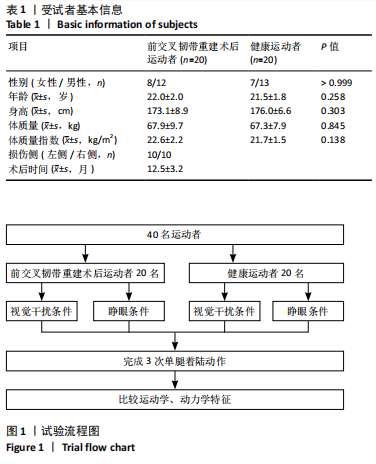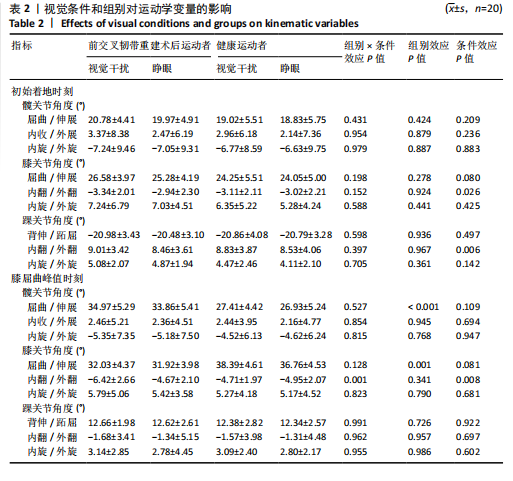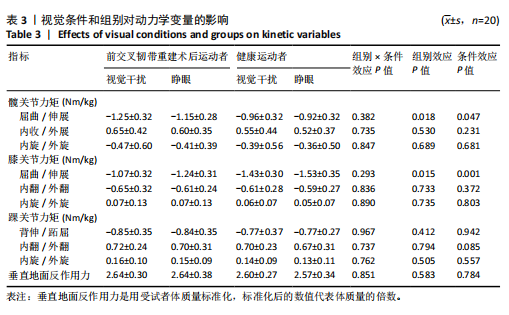[1] MONTALVO AM, SCHNEIDER DK, WEBSTER KE, et al. Anterior Cruciate Ligament Injury Risk in Sport: A Systematic Review and Meta-Analysis of Injury Incidence by Sex and Sport Classification. J Athl Train. 2019; 54(5):472-482.
[2] ZHANG S, WANG L, LIU X, et al. Effects of Kinesio taping on lower limb biomechanical characteristics during the cutting maneuver in athletes after anterior cruciate ligament reconstruction. PLoS One. 2024;19(3):e0299216.
[3] PASCHOS NK, HOWELL SM. Anterior cruciate ligament reconstruction: principles of treatment. EFORT Open Rev. 2016;1(11):398-408.
[4] ZHANG L, JIANG K, CHAI H, et al. A Comparative Animal Study of Tendon Grafts Healing After Remnant-Preserving Versus Conventional Anterior Cruciate Ligament Reconstruction. Med Sci Monit. 2016;22:3426-3437.
[5] LEE BI, KIM CH, JANG BW, et al. Preservation of the Tibial Remnant in Anterior Cruciate Ligament Reconstruction May Improve Postoperative Proprioceptive Function. Orthopedics. 2020;43(4):e231-e236.
[6] RELPH N, HERRINGTON L, TYSON S. The effects of ACL injury on knee proprioception: a meta-analysis. Physiotherapy. 2014;100(3):187-195.
[7] AGEBERG E, FRIDéN T. Normalized motor function but impaired sensory function after unilateral non-reconstructed ACL injury: patients compared with uninjured controls. Knee Surg Sports Traumatol Arthrosc. 2008;16(5):449-456.
[8] JOHNSTON PT, MCCLELLAND JA, WEBSTER KE. Lower Limb Biomechanics During Single-Leg Landings Following Anterior Cruciate Ligament Reconstruction: A Systematic Review and Meta-Analysis. Sports Med. 2018;48(9):2103-2126.
[9] LEPLEY AS, KUENZE CM. Hip and Knee Kinematics and Kinetics During Landing Tasks After Anterior Cruciate Ligament Reconstruction: A Systematic Review and Meta-Analysis. J Athl Train. 2018;53(2):144-159.
[10] CRONSTRöM A, AGEBERG E. Association between sensory function and medio-lateral knee position during functional tasks in patients with anterior cruciate ligament injury. BMC Musculoskelet Disord. 2014;15:430.
[11] CINQUE ME, DORNAN GJ, CHAHLA J, et al. High Rates of Osteoarthritis Develop After Anterior Cruciate Ligament Surgery: An Analysis of 4108 Patients. Am J Sports Med. 2018;46(8):2011-2019.
[12] DINGENEN B, JANSSENS L, LUYCKX T, et al. Postural stability during the transition from double-leg stance to single-leg stance in anterior cruciate ligament injured subjects. Clin Biomech (Bristol, Avon). 2015; 30(3):283-289.
[13] TECCO S, SALINI V, CALVISI V, et al. Effects of anterior cruciate ligament (ACL) injury on postural control and muscle activity of head, neck and trunk muscles. J Oral Rehabil. 2006;33(8):576-587.
[14] GROOMS D, APPELBAUM G, ONATE J. Neuroplasticity following anterior cruciate ligament injury: a framework for visual-motor training approaches in rehabilitation. J Orthop Sports Phys Ther. 2015;45(5): 381-393.
[15] PETERKA RJ. Sensory integration for human balance control. Handb Clin Neurol. 2018;159:27-42.
[16] DOSHER B, LU ZL. Visual Perceptual Learning and Models. Annu Rev Vis Sci. 2017;3:343-363.
[17] XUE X, WANG Y, XU X, et al. Postural Control Deficits During Static Single-leg Stance in Chronic Ankle Instability: A Systematic Review and Meta-Analysis. Sports Health. 2024;16(1):29-37.
[18] WIKSTROM EA, SONG K, PIETROSIMONE BG, et al. Visual Utilization During Postural Control in Anterior Cruciate Ligament- Deficient and -Reconstructed Patients: Systematic Reviews and Meta-Analyses. Arch Phys Med Rehabil. 2017;98(10):2052-2065.
[19] LOUW Q, GILLION N, VAN NIEKERK SM, et al. The effect of vision on knee biomechanics during functional activities - A systematic review. J Sci Med Sport. 2015;18(4):469-474.
[20] WARD S, PEARCE AJ, PIETROSIMONE B, et al. Neuromuscular deficits after peripheral joint injury: a neurophysiological hypothesis. Muscle Nerve. 2015;51(3):327-332.
[21] DHILLON MS, BALI K, PRABHAKAR S. Proprioception in anterior cruciate ligament deficient knees and its relevance in anterior cruciate ligament reconstruction. Indian J Orthop. 2011;45(4):294-300.
[22] WOHL TR, CRISS CR, GROOMS DR. Visual Perturbation to Enhance Return to Sport Rehabilitation after Anterior Cruciate Ligament Injury: A Clinical Commentary. Int J Sports Phys Ther. 2021;16(2):552-564.
[23] HOOTMAN JM, DICK R, AGEL J. Epidemiology of collegiate injuries for 15 sports: summary and recommendations for injury prevention initiatives. J Athl Train. 2007;42(2):311-319.
[24] MCKAY GD, GOLDIE PA, PAYNE WR, et al. Ankle injuries in basketball: injury rate and risk factors. Br J Sports Med. 2001;35(2):103-108.
[25] SCHMITT LC, PATERNO MV, FORD KR, et al. Strength Asymmetry and Landing Mechanics at Return to Sport after Anterior Cruciate Ligament Reconstruction. Med Sci Sports Exerc. 2015;47(7):1426-1434.
[26] HAN S, LEE H, SON SJ, et al. The effects of visual feedback disruption on postural control with chronic ankle instability. J Sci Med Sport. 2022;25(1):53-57.
[27] LEE H, HAN S, SON SJ, et al. Disrupted vision impairs force steadiness and accuracy in chronic ankle instability patients. J Orthop Res. 2023; 41(8):1729-1737.
[28] LIU Q, WANG L, DAI F, et al. Effects of ankle Kinesio taping on knee and ankle joint biomechanics during unanticipated jumps in collegiate athletes. PLoS One. 2024;19(8):e0305480.
[29] WANG L, CHEN P, DING Y, et al. Effects of Kinesio taping on lower limb biomechanical characteristics during unexpected jumping in patients with chronic ankle instability. Scand J Med Sci Sports. 2024; 34(1):e14566.
[30] LEPLEY LK, WOJTYS EM, PALMIERI-SMITH RM. Combination of eccentric exercise and neuromuscular electrical stimulation to improve biomechanical limb symmetry after anterior cruciate ligament reconstruction. Clin Biomech (Bristol, Avon). 2015;30(7):738-747.
[31] LEE H, HAN S, HOPKINS JT. Visual Disruption Influences Neuromechanics during Landing Cutting in Individuals with Chronic Ankle Instability. J Athl Train. 2024;59(8):822-829.
[32] CHEN P, WANG L, DONG S, et al. Abnormal Lower Limb Biomechanics During a Bilateral Vertical Jump Despite the Symmetry in Single-Leg Vertical Hop Height in Athletes After ACL Reconstruction. Orthop J Sports Med. 2024;12(2):23259671241230989.
[33] HEWETT TE, MYER GD, FORD KR. Anterior cruciate ligament injuries in female athletes: Part 1, mechanisms and risk factors. Am J Sports Med. 2006;34(2):299-311.
[34] SONG K, KANG TK, WIKSTROM EA, et al. Effects of reduced plantar cutaneous sensation on static postural control in individuals with and without chronic ankle instability. J Sci Med Sport. 2017;20(10):910-914.
[35] MCKEON PO, HERTEL J. Plantar hypoesthesia alters time-to-boundary measures of postural control. Somatosens Mot Res. 2007;24(4):171-177.
[36] McKeon PO, Hertel J. Spatiotemporal postural control deficits are present in those with chronic ankle instability. BMC Musculoskelet Disord. 2008;9:76.
[37] GROOMS DR, CHAUDHARI A, PAGE SJ, et al. Visual-Motor Control of Drop Landing After Anterior Cruciate Ligament Reconstruction. J Athl Train. 2018;53(5):486-496.
[38] XU Y, SONG B, MING A, et al. Chronic ankle instability modifies proximal lower extremity biomechanics during sports maneuvers that may increase the risk of ACL injury: A systematic review. Front Physiol. 2022;13:1036267.
[39] EMAMVIRDI M, HOSSEINZADEH M, LETAFATKAR A, et al. Comparing kinematic asymmetry and lateral step-down test scores in healthy, chronic ankle instability, and patellofemoral pain syndrome female basketball players: a cross-sectional study. Sci Rep. 2023;13(1):12412.
[40] WREN TAL, MUESKE NM, BROPHY CH, et al. Hop Distance Symmetry Does Not Indicate Normal Landing Biomechanics in Adolescent Athletes With Recent Anterior Cruciate Ligament Reconstruction. J Orthop Sports Phys Ther. 2018;48(8):622-629.
[41] 陈鹏,左会武,王玲,等.前交叉韧带重建术后运动者单腿垂直跳跃高度对称性掩盖其异常下肢生物力学[J].中国运动医学杂志, 2023,42(12):939-947.
[42] CHEN P, WANG L, DONG S, et al. Can Symmetry of Single-Leg Vertical Jump Height Represent Normal Lower Limb Biomechanics of Athletes After Anterior Cruciate Ligament Reconstruction? Sports Health. 2024; 16(4):596-605.
[43] OIESTAD BE, HOLM I, AUNE AK, et al. Knee function and prevalence of knee osteoarthritis after anterior cruciate ligament reconstruction: a prospective study with 10 to 15 years of follow-up. Am J Sports Med. 2010;38(11):2201-2210.
[44] SRITHARAN P, MUñOZ MA, PIVONKA P, et al. Biomechanical Markers of Forward Hop-Landing After ACL-Reconstruction: A Pattern Recognition Approach. Ann Biomed Eng. 2022;50(3):330-342.
[45] KIM H, SON SJ, SEELEY MK, et al. Kinetic Compensations due to Chronic Ankle Instability during Landing and Jumping. Med Sci Sports Exerc. 2018;50(2):308-317.
[46] SYMEONIDOU ER, FERRIS DP. Visual Occlusions Result in Phase Synchrony Within Multiple Brain Regions Involved in Sensory Processing and Balance Control. IEEE Trans Neural Syst Rehabil Eng. 2023;31:3772-3780.
[47] KIM KM, KIM JS, GROOMS DR. Stroboscopic Vision to Induce Sensory Reweighting During Postural Control. J Sport Rehabil. 2017;26(5):1-11.
[48] CLARK JF, ELLIS JK, BENCH J, et al. High-performance vision training improves batting statistics for University of Cincinnati baseball players. PLoS One. 2012;7(1):e29109.
[49] MITROFF SR, FRIESEN P, BENNETT D, et al. Enhancing ice hockey skills through stroboscopic visual training: a pilot study. Athletic Training & Sports Health Care. 2013;5(6):261-264.
[50] HüLSDüNKER T, GUNASEKARA N, MIERAU A. Short- and Long-Term Stroboscopic Training Effects on Visuomotor Performance in Elite Youth Sports. Part 1: Reaction and Behavior. Med Sci Sports Exerc. 2021;53(5):960-972.
[51] HüLSDüNKER T, GUNASEKARA N, MIERAU A. Short- and Long-Term Stroboscopic Training Effects on Visuomotor Performance in Elite Youth Sports. Part 2: Brain-Behavior Mechanisms. Med Sci Sports Exerc. 2021; 53(5):973-985. |


